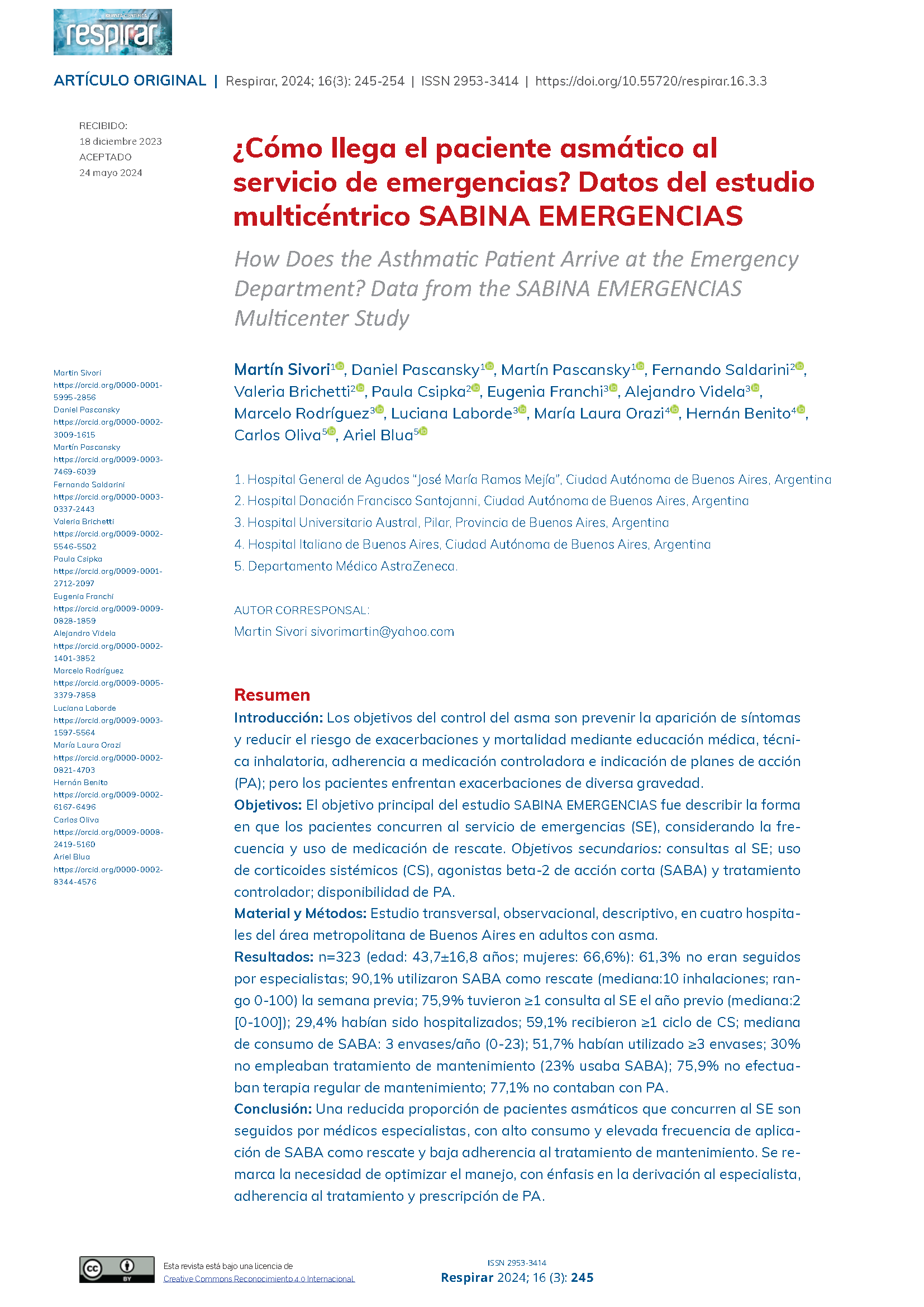¿Cómo llega el paciente asmático al servicio de emergencias? Datos del estudio multicéntrico SABINA EMERGENCIAS
Contenido principal del artículo
Resumen
Introducción: Los objetivos del control del asma son prevenir la aparición de síntomas y reducir el riesgo de exacerbaciones y mortalidad mediante educación médica, técnica inhalatoria, adherencia a medicación controladora e indicación de planes de acción (PA); pero los pacientes enfrentan exacerbaciones de diversa gravedad. El objetivo principal del estudio SABINA EMERGENCIAS fue describir la forma en que los pacientes concurren al servicio de emergencias (SE), considerando la frecuencia y uso de medicación de rescate. Objetivos secundarios: consultas al SE; uso de corticoides sistémicos (CS), agonistas beta-2 de acción corta (SABA) y tratamiento controlador; disponibilidad de PA.
Métodos: Estudio transversal, observacional, descriptivo, en 4 hospitales del área metropolitana de Buenos Aires en adultos con asma.
Resultados: n=323 (edad:43,7±16,8 años; mujeres:66,6%): 61,3% no eran seguidos por especialistas; 90,1% utilizaron SABA como rescate (mediana:10 inhalaciones; rango 0-100) la semana previa; 75,9% tuvieron ≥1 consulta al SE el año previo (mediana:2 [0-100]); 29,4% habían sido hospitalizados; 59,1% recibieron ≥1 ciclo de CS; mediana de consumo de SABA: 3 envases/año (0-23); 51,7% habían utilizado ≥3 envases; 30% no empleaban tratamiento de mantenimiento (23% usaba SABA); 75,9% no efectuaban terapia regular de mantenimiento; 77,1% no contaban con PA.
Conclusión: Una reducida proporción de pacientes asmáticos que concurren al SE son seguidos por médicos especialistas, con alto consumo y elevada frecuencia de aplicación de SABA como rescate y baja adherencia al tratamiento de mantenimiento. Se remarca la necesidad de optimizar el manejo, con énfasis en la derivación al especialista, adherencia al tratamiento y prescripción de PA.
Detalles del artículo
Sección

Esta obra está bajo una licencia internacional Creative Commons Atribución 4.0.
Cómo citar
Referencias
Ministerio de Salud de la Nación. Protocolo de Orientación Para El Diagnóstico y Manejo Del Asma En Adultos. 2016. [Internet]. [Consultado 12 abr 2024]. Disponible en: https://iah.salud.gob.ar/doc/Documento166.pdf
Arias SJ, Neffen H, Bossio JC et al. Prevalencia y características clínicas del asma en adultos jóvenes en zonas urbanas de Argentina. Arch Bronconeumol 2018;54(3):134–139. Doi: 10.1016/j.arbres.2017.08.021.
Global Initiative for Asthma. Global Strategy for Asthma Management and Prevention, Updated 2023. [Internet]. [Consultado 12 abr 2024]. Disponible en:https://ginasthma.org/wp-content/uploads/2023/07/GINA-2023-Full-report-23_07_06-WMS.pdf
Bourdin A, Bjermer L, Brightling C et al. ERS/EAACI statement on severe exacerbations in asthma in adults: facts, priorities and key research questions. Eur Respir J 2019;54(3):1900900. Doi: 10.1183/13993003.00900-2019.
Stanford RH, Shah MB, D’Souza AO et al. Short-acting β-agonist use and its ability to predict future asthma-related outcomes. Ann Allergy Asthma Immunol 2012;109(6):403–407. Doi: 10.1016/j.anai.2012.08.014.
Suissa S, Ernst P, Boivin JF et al. A cohort analysis of excess mortality in asthma and the use of inhaled beta-agonists. Am J Respir Crit Care Med 1994;149(3 Pt 1):604–610. Doi: 10.1164/ajrccm.149.3.8118625.
van der Valk RJP, Baraldi E, Stern G et al. Daily exhaled nitric oxide measurements and asthma exacerbations in children. Allergy 2012;67(2):265–271. Doi: 10.1111/j.1398-9995.2011.02734.x.
Mattarucco W, Altieri H BR. Patrón de prescripción de agonistas beta-2 de acción corta y potenciales efectos sobre el control del asma: cohorte argentina del estudio SABINA III. Rev Arg Med 2022;10(2):116–123.
Castiglioni N, Ledesma F, Zuccarino N et al. Consumo de beta-2 agonistas de acción corta en farmacias de la Ciudad de Córdoba (Pharmacy Survey). Rev Farm 2022;164(2):31–36.
Chirino G, del Olmo R, Castaño G. El asma no controlada en la atención primaria: implementación y uso práctico de ReferID. Respirar 2023;15(2); 81-87. Doi: 10.55720/respirar.15.2.1.
Maillo M, Valdez P, Camargo G et al. Manejo de la crisis asmática en el adulto. Rev Arg Med 2022;10((Supl. 1)):S36–S43.
Most JF, Ambrose CS, Chung Y et al. Real-World Assessment of Asthma Specialist Visits Among U.S. Patients with Severe Asthma. J Allergy Clin Immunol Pract 2021;9(10):3662-3671.e1. Doi: 10.1016/j.jaip.2021.05.003.
Lenhardt RO, Catrambone CD, Walter J et al. The asthma emergency department visit: treating a crisis in the midst of uncontrolled disease. Ann Allergy Asthma Immunol 2008;100(3):237–243. Doi: 10.1016/S1081-1206(10)60448-6.
Nannini LJ, Luhning S, Rojas RA et al. Position statement: asthma in Latin America. IS short-acting beta-2 agonist helping or compromising asthma management? J Asthma 2021;58(8):991–994. Doi: 10.1080/02770903.2020.1777563.
Maspero JF, Jardim JR, Aranda A et al. Insights, attitudes, and perceptions about asthma and its treatment: findings from a multinational survey of patients from Latin America. World Allergy Organ J 2013;6(1):19. Doi: 10.1186/1939-4551-6-19.
Neffen H, Fritscher C, Schacht FC et al. Asthma control in Latin America: the Asthma Insights and Reality in Latin America (AIRLA) survey. Rev Panam Salud Publica 2005;17(3):191–197. Doi: 10.1590/s1020-49892005000300007.
George M, Bender B. New insights to improve treatment adherence in asthma and COPD. Patient Prefer Adherence 2019;13:1325–1334. Doi: 10.2147/PPA.S209532.
Williams LK, Peterson EL, Wells K et al. Quantifying the proportion of severe asthma exacerbations attributable to inhaled corticosteroid nonadherence. J Allergy Clin Immunol 2011;128(6):1185-1191.e2. Doi: 10.1016/j.jaci.2011.09.011.
Gillisen A. Patient’s adherence in asthma. J Physiol Pharmacol 2007;58 Suppl 5(Pt 1):205–222.
Sívori M, Pascansky D. Costos directos en asma aguda hospitalizada en un hospital público de la Ciudad de Buenos Aires. Rev Am Med Resp 2020;20(2):132–140.
Goronfolah L, Abulaban A, Barnawi AI et al. The Effectiveness of Written Asthma Action Plan at the National Guard Health Affairs’ Asthma Clinic. Cureus 2019;11(11):e6247. Doi: 10.7759/cureus.6247.
